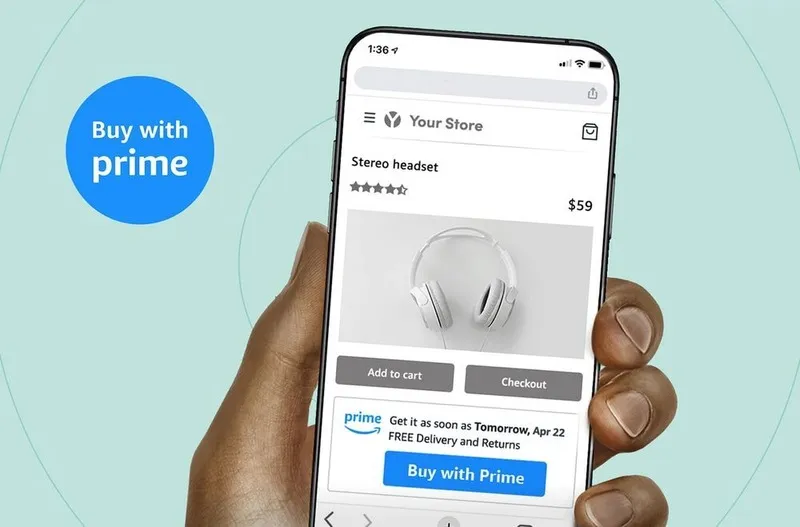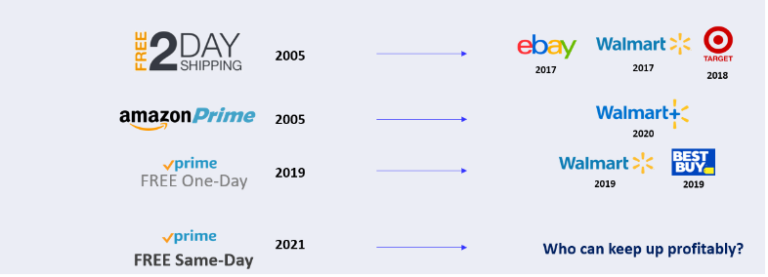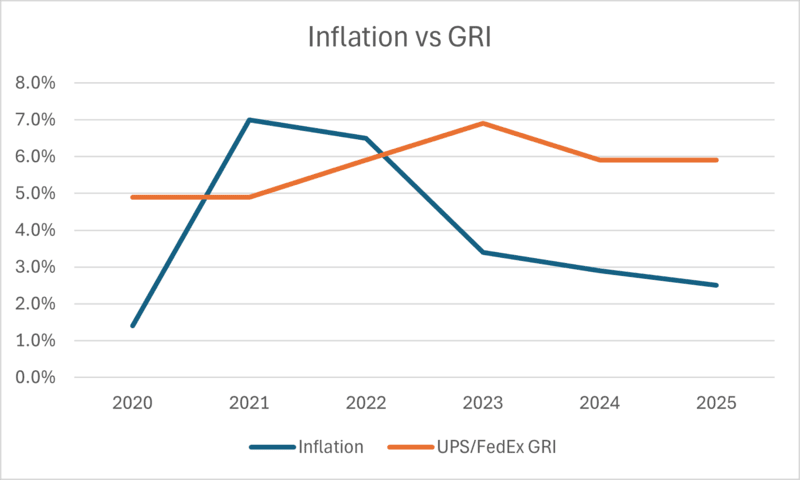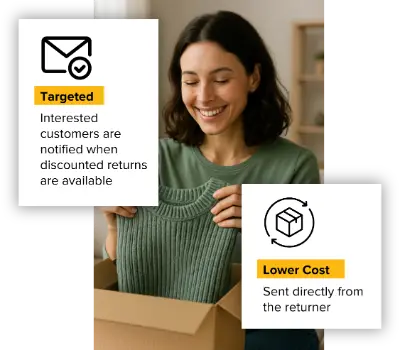Ecommerce Fulfillment with Buy With Prime

Last updated on March 26, 2025

Consumer expectations today are higher than they’ve ever been before. Many observers might put this down to rising incomes or things that shoppers visibly see every day, such as great marketing campaigns, innovative products, or competitive pricing. However, sellers have a secret weapon in the competition to acquire happy, loyal customers – fast, free shipping and order fulfillment.
The elevated customer expectations that online retailers face due to fast shipping times have been created by the “Amazon Prime Effect”. What is this effect, and what implications does it have for merchants selling online?
Constantly Increasing Consumer Expectations
Let’s go back to 2005, when Amazon introduced free two-day shipping on orders over $35, a move that many found puzzling – even illogical – at the time. Later in the same year, they introduced Prime, with its annual fee that allowed customers to get as many items as they wanted, with no shipping fees.
By the time of the Covid-19 pandemic, same-day shipping arrived on Prime. While Amazon continuing to raise the fulfillment bar has been great for them and their customers, competitors large and small have been scrambling to catch up. For example, it took Walmart 12 years to catch up and offer free 2-day shipping! As Amazon has gotten faster and faster at shipping, even their biggest competitors have taken a long time to reach the elevated shipping standards that Amazon makes table stakes.
On every channel today, the sellers winning are those offering shipping that can compete with Amazon. For example, Walmart listings (inspired by Amazon’s approach) offering 2-day delivery rank higher in search results, win the buy box more often, and see conversion lifts as high as 50%.

While pressures to provide ever-faster free shipping continue to increase, the pressures of intensifying competition are making it harder than ever for sellers to win. Costs at each step of the fulfillment chain (shipping, warehousing, and labor) are on the rise:
- Shipping: General Rate Increases have surged upward, remaining significantly higher than the prevailing inflation rate, making it harder and harder for merchants to absorb the last-mile costs involved in meeting the expectations of free same-day shipping.

- Warehousing: To get orders fulfilled faster, you need to distribute your inventory in warehouses closer to the customer. But online merchants face the challenge of dealing with both elevated rent costs and limited vacant space in warehouses.
- Labor: As they continue to face significant staff turnover at fulfillment centers, Amazon has had to increase the wage they pay their workers several times in recent years. Most recently in 2024, they announced a new 7% increase in base pay for warehouse workers, bringing average base pay for such workers above $22/hr.
With shipping companies raising prices, warehouses becoming tougher to rent, and people becoming more expensive to hire, merchants face the daunting task of overcoming these challenges and meeting customer expectations.
What is Buy with Prime?
In 2022, Amazon raised the stakes yet again, making fast, free shipping available standard for every e-commerce brand and retailer through their Buy with Prime (BWP) program. This program allows any online merchant – not only those with Amazon stores – to offer order fulfillment using the elevated standard set by Prime. The program has already made a splash in a short time, with support from major brands such as Adidas and Fossil.
Amazon Buy with Prime is a program that allows third-party merchants to offer Prime shopping benefits—like fast, free shipping, a seamless checkout experience, and easy returns—on their own e-commerce websites. It integrates with a merchant’s online store, enabling Amazon Prime members to shop with confidence outside of Amazon.com while still receiving the perks they expect.
Any merchant with a Direct-to-Consumer (DTC) website and an Amazon Seller Central or Amazon Supply Chain account can apply for the Buy with Prime program. Merchants simply add the “Buy with Prime” button to their product pages on their own website, and customers then check out using their Amazon credentials, making the process faster and more convenient.
Amazon handles fulfillment and shipping, ensuring fast delivery through its logistics network, and also manages customer service and returns, simplifying post-purchase interactions.
Slash Your Fulfillment Costs by Up to 30%
Cut shipping expenses by 30% and boost profit with Cahoot's AI-optimized fulfillment services and modern tech —no overheads and no humans required!
I'm Interested in Saving Time and MoneyBenefits of Buy With Prime
Amazon’s Buy with Prime program offers significant advantages for sellers looking to boost sales and improve their customer experience. By enabling merchants to offer the Prime shopping experience directly on their own websites, the program increases trust and boosts consumer spending – by 16% on average according to Amazon! With fast, free shipping and a seamless checkout experience backed by Amazon’s fulfillment network, sellers can attract high-value Prime members who are accustomed to quick delivery and hassle-free returns.
Additionally, Buy with Prime helps sellers leverage Amazon’s logistics expertise without being limited to selling only on Amazon’s marketplace. They maintain control over their branding and customer relationships while benefiting from Amazon’s fulfillment and payment processing capabilities. Merchants can feature reviews from Amazon on their website and place ads on the Amazon Marketplace which link to their own website and drive traffic. The program can also reduce cart abandonment rates, as shoppers are more likely to complete a purchase when they recognize the reliability of Prime.
Limitations and Problems of Buy With Prime
Only SKUs that are fulfilled using FBA (Amazon’s in-house fulfillment) are Buy with Prime eligible. While FBA works well, the Buy with Prime button disappears from the product listing on your website if there is no more inventory available in Amazon warehouses, and standard FBA fees and regulations apply to all inventory in an Amazon fulfillment center. FBA is not ideal for SKUs that do not move quickly – the costs associated with stocking inventory with Amazon that does not turn over frequently can become very large.
The most imposing drawback to the Buy with Prime program, however, is the significant payment processing fees, representing 2.4% of the cart value + $0.30, as well as an additional 3% Prime service fee (min $1.00). Shopify stores can avoid much of the pain associated with these fees, as their payment processing fees are waived and only standard Shopify fees (and the Prime service fee) apply. That being said, sellers should remember that other applicable FBA fees (storage, etc.) will also apply to orders fulfilled from Shopify stores.
Alternatives to Buy with Prime
For sellers seeking to aggressively minimize the costs associated with fulfillment, Amazon’s FBA and Multi-Channel Fulfillment (MCF) programs are, on average, cheaper than utilizing Buy with Prime (although there are specific product types for which Buy with Prime may be more efficient than MCF). But what about merchants who want to meet the modern standard for fast, cost-effective shipping without losing control of their fulfillment processes or submitting to the rigid requirements for which Amazon has become infamous?
Usually, merchants look to 3rd Party Logistics Providers (3PLs) for solutions. However, 3PLs can often come with significant costs and limitations, as fulfillment is their primary revenue stream.
That’s where a solution like Cahoot comes in – we’re unlocking the potential of over 2 million e-commerce retailers in the US that have their own warehouse space, who perform complete order fulfillment.
For the first time ever, merchants, brands, and e-commerce retailers will be able to monetize excess capacity available in their warehouses through Cahoot’s peer-to-peer order fulfillment network, which delivers fast, free 1-2 day shipping while also lowering costs. We offer the industry’s leading Service Level Agreement (SLA) and we help our Amazon sellers by offering Seller Fulfilled Prime (SFP) services. If you’d like us to take over all aspects of order fulfillment, we can do that too!
Looking for a New 3PL? Start with this Free RFP Template
Cut weeks off your selection process. Avoid pitfalls. Get the only 3PL RFP checklist built for ecommerce brands, absolutely free.
Get My Free 3PL RFPConclusion
In an era where fast, free shipping is no longer a luxury but an expectation, sellers must carefully weigh their fulfillment options. Buy with Prime offers a compelling way to boost conversion rates and leverage Amazon’s logistics, but it comes with added costs and limitations that may not work for every merchant. While some sellers may find Amazon’s fulfillment solutions ideal, others may prefer alternative strategies that provide more control over operations and costs.
As competition intensifies and fulfillment challenges grow, innovative solutions like Cahoot’s peer-to-peer fulfillment network are emerging as viable alternatives. By leveraging existing warehouse capacity and a decentralized fulfillment model, sellers can meet the demand for fast, cost-effective shipping without the constraints of Amazon’s ecosystem. The key to success in today’s e-commerce landscape lies in choosing the right fulfillment strategy—one that balances speed, cost, and control to drive long-term growth.
Frequently Asked Questions
How does Buy with Prime benefit merchants?
Buy with Prime helps sellers leverage Amazon’s logistics expertise without being limited to selling only on Amazon’s marketplace. They maintain control over their branding and customer relationships while benefiting from Amazon’s fulfillment and payment processing capabilities. Merchants can feature reviews from Amazon on their website and place ads on the Amazon Marketplace which link to their own website and drive traffic.
What are the limitations of Buy with Prime?
Only SKUs that are fulfilled using FBA (Amazon’s in-house fulfillment) are Buy with Prime eligible. The Buy with Prime button disappears from the product listing on your website if there is no more inventory available in Amazon warehouses, and standard FBA fees and regulations apply to all inventory in an Amazon fulfillment center. Additionally, significant payment processing fees often apply.
This is why it’s important for sellers seeking to aggressively reduce the costs associated with fulfillment, to research alternatives to Buy with Prime.

Turn Returns Into New Revenue


 8 minutes
8 minutes